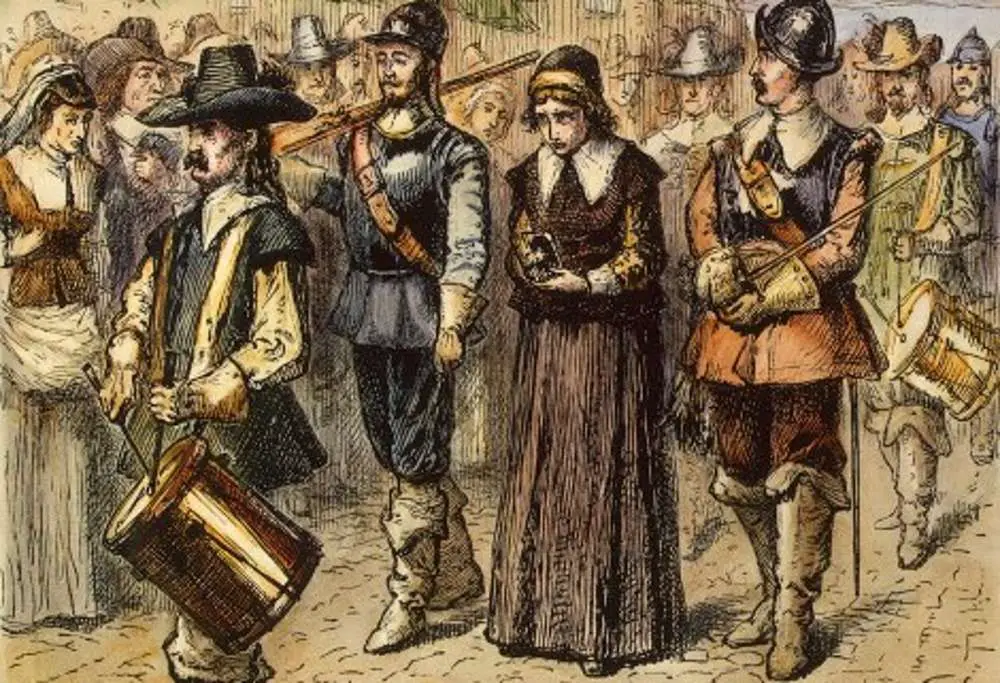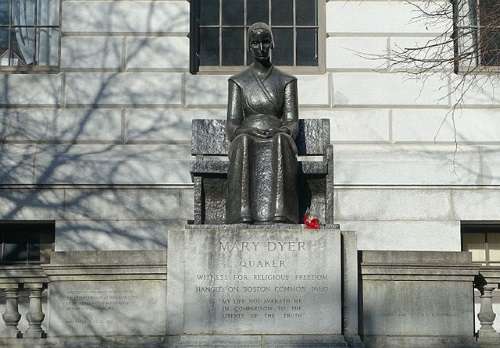Humphrey Atherton had far more power and influence than the Quakers he persecuted in the Massachusetts Bay Colony during the 1650s.
At least one of his victims, Mary Dyer, has gone down in history as a courageous woman whose stand against religious intolerance cost her her life.
Her statue stands in front of the Massachusetts Statehouse, and schoolchildren learn of her martyrdom to this day.
As for Humphrey Atherton, he is remembered mostly for his violent death, said to result from a curse placed on him by one of his victims.
Humphrey Atherton
He was born in England sometime around 1608 and came to Massachusetts during the Great Migration of Puritans. He brought with him his wife, who he had married when they were both 15. They had three children, and would have nine more.

Puritans arrive in Massachusetts, ‘Arrival of Winthrop’s Company in Boston Harbor’ by William Formby Halsall, ca. 1630.
Humphrey Atherton quickly rose to power in the young colony. He won election as selectman and treasurer and eventually served as Speaker of the House. For many years he served as a justice of the peace. He officiated over many marriages, including that of Myles Standish, Jr., and Sarah Winslow.
Atherton belonged to the Ancient and Honorable Artillery Company and organized the first militia in Dorchester. He became the highest ranking military officer in New England. As major-general in the Suffolk Regiment, his responsibilities included subduing Indians and catching criminals, like Quakers.
Humphrey Atherton also served as a member of the Court of Assistance. That gave him the power to prosecute criminals and heretics. He embraced that power with gusto.
He played a major role in the capital punishment of at least one witch, Mrs. Ann Hibbins. She later appeared as Mrs. Hibbins in Nathaniel Hawthorne’s The Scarlet Letter.
Quakers especially resented Humphrey Atherton’s insult toward Mary Dyer. As her body dangled from the noose, Atherton supposedly said, “She hangs there like a flag.”
Death
According to legend, Wenlock Christison, the last Quaker sentenced to death, had an exchange with Humphrey Atherton.
Joseph Besse, an English Quaker who chronicled the sufferings of Quakers, wrote about it.
Humphrey Atherton said to Christison, “You pronounce woes and judgments, and those that are gone before you pronounced woes and judgments; but the judgments of the Lord God are not upon us yet.”
Christison then told Atherton he would face God’s judgment. Christison, however, won a reprieve.
On Sept. 16, 1661, Atherton drilled his militia with ‘much pomp and ostentation.’ He then rode his horse home through Boston Common. He came to the place where officials released Quakers from a cart after they whipped them.
His horse suddenly shied, and threw Humphrey Atherton with such violence that he died instantly. Wrote Besse:
His eyes being dashed out of his head, and his brains coming out of his nose, his tongue hanging out at his mouth, and the blood running out at his ears.
Men took up his body and brought it into the courthouse where he had sentenced Quakers to death. “His blood ran through the floor,” wrote Besse, “exhibiting to the spectators a shocking instance of the Divine vengeance against a daring and hardened persecutor.”
Afterward
Humphrey Atherton’s remains now lie in the Old North Burying Ground in the Dorchester section of Boston. Harlow Elliot Woodword, in Epitaphs from the Old Burying Ground in Dorchester, wrote that Quakers ‘believed his horrible death to be God’s visitation of wrath.’
Henry Wadsworth Longfellow included the curse of Humphrey Atherton in his play, John Endicott.
His descendants include rocket scientist Robert Goddard, suffragist Susan B. Anthony, U.S. Secretary of War Henry Stimson and actress Raquel Welch.
Images: Tomb of Humphrey Atherton By Ishtar456 – Own work, CC BY 3.0, https://commons.wikimedia.org/w/index.php?curid=11255440. This story was updated in 2024.




